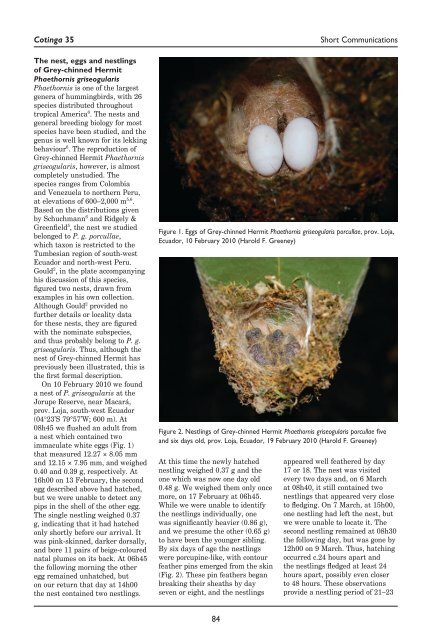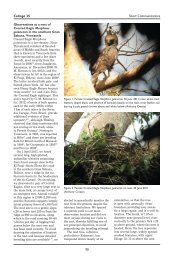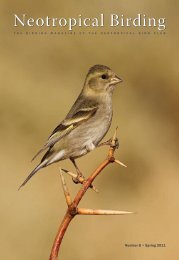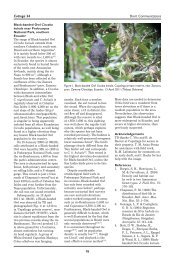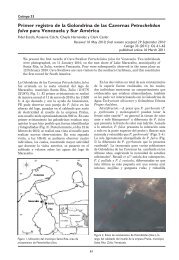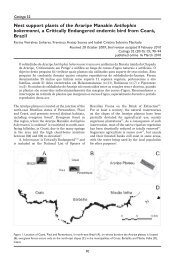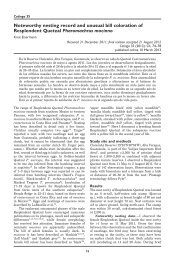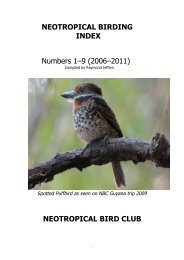The nest, eggs and nestlings of Grey-chinned Hermit Phaethornis ...
The nest, eggs and nestlings of Grey-chinned Hermit Phaethornis ...
The nest, eggs and nestlings of Grey-chinned Hermit Phaethornis ...
You also want an ePaper? Increase the reach of your titles
YUMPU automatically turns print PDFs into web optimized ePapers that Google loves.
Cotinga 35<strong>The</strong> <strong>nest</strong>, <strong>eggs</strong> <strong>and</strong> <strong>nest</strong>lings<strong>of</strong> <strong>Grey</strong>-<strong>chinned</strong> <strong>Hermit</strong><strong>Phaethornis</strong> griseogularis<strong>Phaethornis</strong> is one <strong>of</strong> the largestgenera <strong>of</strong> hummingbirds, with 26species distributed throughouttropical America 6 . <strong>The</strong> <strong>nest</strong>s <strong>and</strong>general breeding biology for mostspecies have been studied, <strong>and</strong> thegenus is well known for its lekkingbehaviour 6 . <strong>The</strong> reproduction <strong>of</strong><strong>Grey</strong>-<strong>chinned</strong> <strong>Hermit</strong> <strong>Phaethornis</strong>griseogularis, however, is almostcompletely unstudied. <strong>The</strong>species ranges from Colombia<strong>and</strong> Venezuela to northern Peru,at elevations <strong>of</strong> 600–2,000 m 5,6 .Based on the distributions givenby Schuchmann 6 <strong>and</strong> Ridgely &Greenfield 5 , the <strong>nest</strong> we studiedbelonged to P. g. porcullae,which taxon is restricted to theTumbesian region <strong>of</strong> south-westEcuador <strong>and</strong> north-west Peru.Gould 2 , in the plate accompanyinghis discussion <strong>of</strong> this species,figured two <strong>nest</strong>s, drawn fromexamples in his own collection.Although Gould 2 provided n<strong>of</strong>urther details or locality datafor these <strong>nest</strong>s, they are figuredwith the nominate subspecies,<strong>and</strong> thus probably belong to P. g.griseogularis. Thus, although the<strong>nest</strong> <strong>of</strong> <strong>Grey</strong>-<strong>chinned</strong> <strong>Hermit</strong> haspreviously been illustrated, this isthe first formal description.On 10 February 2010 we founda <strong>nest</strong> <strong>of</strong> P. griseogularis at theJorupe Reserve, near Macará,prov. Loja, south-west Ecuador(04°23’S 79°57’W; 600 m). At08h45 we flushed an adult froma <strong>nest</strong> which contained twoimmaculate white <strong>eggs</strong> (Fig. 1)that measured 12.27 × 8.05 mm<strong>and</strong> 12.15 × 7.95 mm, <strong>and</strong> weighed0.40 <strong>and</strong> 0.39 g, respectively. At16h00 on 13 February, the secondegg described above had hatched,but we were unable to detect anypips in the shell <strong>of</strong> the other egg.<strong>The</strong> single <strong>nest</strong>ling weighed 0.37g, indicating that it had hatchedonly shortly before our arrival. Itwas pink-skinned, darker dorsally,<strong>and</strong> bore 11 pairs <strong>of</strong> beige-colourednatal plumes on its back. At 06h45the following morning the otheregg remained unhatched, buton our return that day at 14h00the <strong>nest</strong> contained two <strong>nest</strong>lings.Short CommunicationsFigure 1. Eggs <strong>of</strong> <strong>Grey</strong>-<strong>chinned</strong> <strong>Hermit</strong> <strong>Phaethornis</strong> griseogularis porcullae, prov. Loja,Ecuador, 10 February 2010 (Harold F. Greeney)Figure 2. Nestlings <strong>of</strong> <strong>Grey</strong>-<strong>chinned</strong> <strong>Hermit</strong> <strong>Phaethornis</strong> griseogularis porcullae five<strong>and</strong> six days old, prov. Loja, Ecuador, 19 February 2010 (Harold F. Greeney)At this time the newly hatched<strong>nest</strong>ling weighed 0.37 g <strong>and</strong> theone which was now one day old0.48 g. We weighed them only oncemore, on 17 February at 06h45.While we were unable to identifythe <strong>nest</strong>lings individually, onewas significantly heavier (0.86 g),<strong>and</strong> we presume the other (0.65 g)to have been the younger sibling.By six days <strong>of</strong> age the <strong>nest</strong>lingswere porcupine-like, with contourfeather pins emerged from the skin(Fig. 2). <strong>The</strong>se pin feathers beganbreaking their sheaths by dayseven or eight, <strong>and</strong> the <strong>nest</strong>lingsappeared well feathered by day17 or 18. <strong>The</strong> <strong>nest</strong> was visitedevery two days <strong>and</strong>, on 6 Marchat 08h40, it still contained two<strong>nest</strong>lings that appeared very closeto fledging. On 7 March, at 15h00,one <strong>nest</strong>ling had left the <strong>nest</strong>, butwe were unable to locate it. <strong>The</strong>second <strong>nest</strong>ling remained at 08h30the following day, but was gone by12h00 on 9 March. Thus, hatchingoccurred c.24 hours apart <strong>and</strong>the <strong>nest</strong>lings fledged at least 24hours apart, possibly even closerto 48 hours. <strong>The</strong>se observationsprovide a <strong>nest</strong>ling period <strong>of</strong> 21–2384
Cotinga 35Figure 3. Adult <strong>Grey</strong>-<strong>chinned</strong> <strong>Hermit</strong><strong>Phaethornis</strong> griseogularis porcullaeincubating two <strong>eggs</strong>, prov. Loja,Ecuador, 12 February 2010 (Harold F.Greeney)days for P. griseogularis, similarto that reported for other small<strong>Phaethornis</strong> 3,6–8 .In typical hermit style, the <strong>nest</strong>was attached to the underside <strong>of</strong>a leaf, 1.3 m above the ground(Fig. 3), at the bottom <strong>of</strong> a smallriparian area. <strong>The</strong> leaf belonged toan unknown species <strong>of</strong> Lauraceae,<strong>and</strong> measured c.28 cm long by 6.5cm wide (max. dimensions). <strong>The</strong><strong>nest</strong> comprised a complex mix<strong>of</strong> small bark pieces, seed down,small dried flower inflorescences<strong>and</strong> (predominantly) green moss. Itwas bound together <strong>and</strong> attachedto the leaf with copious spiderwebs, <strong>and</strong> had a sparse innerlining <strong>of</strong> s<strong>of</strong>t white seed down(Fig. 1). <strong>The</strong> front rim (furthestfrom the leaf) was c.1 cm lowerthan the portion attached to theleaf. Internally the cup measured28 mm wide by 24 mm deep atthe shallowest point. Externallythe <strong>nest</strong> was 47 mm wide by 38mm front to back (perpendicularto the axis <strong>of</strong> the leaf blade). Fromthe back rim <strong>of</strong> the <strong>nest</strong> (againstthe leaf) to the tip <strong>of</strong> the leaf itmeasured 49 mm, <strong>and</strong> 32 mmfrom the front rim. <strong>The</strong> <strong>nest</strong> hada well-formed ‘tail’ <strong>of</strong> materialdangling below the leaf, whichextended 11 cm, with an additional4 cm <strong>of</strong> sparse scraps below this.Unsurprisingly, the <strong>nest</strong>sillustrated by Gould 2 appear verysimilar to the <strong>nest</strong> described here,including having the appearance<strong>of</strong> being composed, at leastexternally, <strong>of</strong> moss <strong>and</strong> seeddown. Similarly, the <strong>nest</strong> <strong>of</strong> P.griseogularis closely resembles,in form <strong>and</strong> attachment, those<strong>of</strong> other <strong>Phaethornis</strong> 6 , includingtwo well-studied species thoughtto be closely related; StripethroatedP. striigularis 4,7,8 <strong>and</strong>Reddish <strong>Hermit</strong>s P. ruber 1,3 . <strong>The</strong>other two presumed relatives <strong>of</strong>P. griseogularis, Black-throated<strong>Hermit</strong> P. atrimentalis <strong>and</strong> Whitebrowed<strong>Hermit</strong> P. stuarti still lackpublished descriptions <strong>of</strong> their<strong>nest</strong>s.AcknowledgementsWe thank Field Guides Inc.,John V. & the late Ruth AnnMoore, Matt Kaplan, Tim Metz,the PBNHS, Population BiologyFoundation <strong>and</strong> Tom Walla forsupporting HFG’s field work.Members <strong>of</strong> Jocotoco Foundation<strong>and</strong> staff at Jorupe Reserve, inparticular Leonidas E. Cabrera,were instrumental in completingthis study. We thank Juan FreileShort Communications<strong>and</strong> an anonymous reviewer forimprovements to the manuscript.References1. Davis, T. A. W. (1958) <strong>The</strong>displays <strong>and</strong> <strong>nest</strong>s <strong>of</strong> threeforest hummingbirds. Ibis100: 31–39.2. Gould, J. (1861) A monograph<strong>of</strong> the Trochilidae, 1. London,UK: Taylor & Francis.3. Oniki, Y. (1970) Nestingbehavior <strong>of</strong> Reddish <strong>Hermit</strong>s(<strong>Phaethornis</strong> ruber) <strong>and</strong>occurrence <strong>of</strong> wasp cells in<strong>nest</strong>s. Auk 87: 720–728.4. Peck, M. E. (1910) <strong>The</strong> effect<strong>of</strong> natural enemies on the<strong>nest</strong>ing habits <strong>of</strong> someBritish Honduras birds.Condor 12: 53–60.5. Ridgely, R. S. & Greenfield,P. J. (2001) <strong>The</strong> birds <strong>of</strong>Ecuador. Ithaca, NY: CornellUniversity Press.6. Schuchmann, K. -L. (1999)Family Trochilidae(hummingbirds). In: delHoyo, J., Elliott, A. &Sargatal, J. (eds.) H<strong>and</strong>book<strong>of</strong> the birds <strong>of</strong> the world, 5.Barcelona: Lynx Edicions.7. Skutch, A. F. (1951) Lifehistory <strong>of</strong> Longuemare’s<strong>Hermit</strong> hummingbird. Ibis93: 180–195.8. Skutch, A. F. (1964) Lifehistories <strong>of</strong> hermithummingbirds. Auk 81: 5–25.Harold F. Greeney, IsaacLichter-Marck <strong>and</strong> Eli Lichter-MarckYanayacu Biological Station& Center for Creative Studies,Cosanga, Napo, Ecuador; c/o 721Foch & Amazonas, Quito, Ecuador.E-mail: revmmoss@yahoo.com.Received 10 October 2011; finalrevision accepted 11 August 2012;published online 10 March 201385


